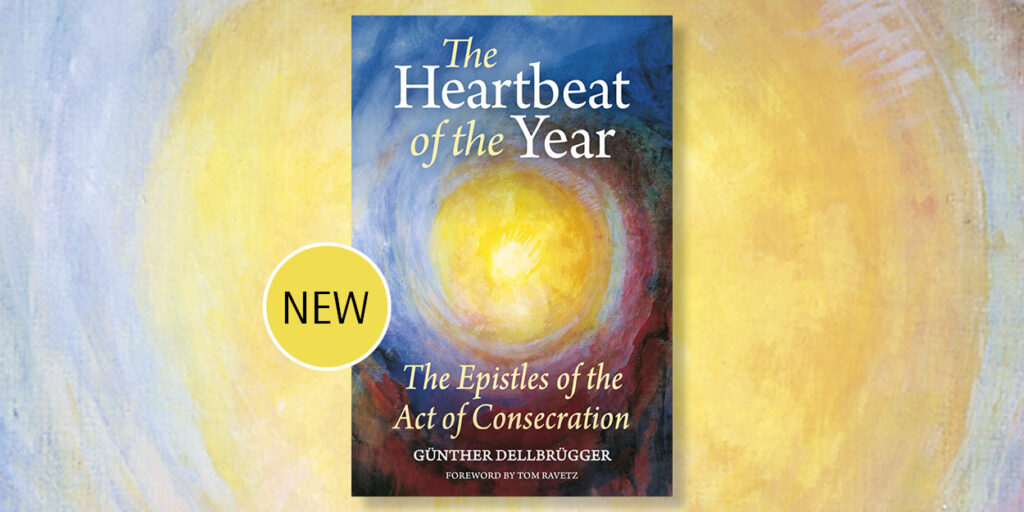Inside The Heartbeat of the Year: The Epistles of the Act of Consecration
by Floris Books • 21 October 2025 • Religion, The Christian Community • 0 Comments

The epistles of the Act of Consecration are special prayers that are heard at the beginning and end of the communion service of The Christian Community. They follow the path of the Christian year and, through subtle changes in mood and tone, reflect the changing seasons and the accompanying festivals.
In The Heartbeat of the Year: The Epistles of the Act of Consecration, retired Christian Community priest Günther Dellbrügger gathers these prayers together for the first time. Dellbrügger uses a range of sources – from the Bible and poetry to examples taken from real life – to bring fresh perspectives to the epistles that help readers become more alert to the delicate changes of these prayers as they progress throughout the year. Contemplations by Rudolf Frieling, a founder of The Christian Community, provide important context to the epistles’ origins, including when and how they were first given.
Here we share an extract from the chapter on Advent, where Dellbrügger explores the positive impact Christian festivals can have on our lives.
Set Forth, Become Light
Advent is a spiritual New Year, when a new cycle of festivals begins. It is the time for deepening our inner Christian life. We see repetition in the festival cycle on a yearly basis, but we can picture it more as a spiral than a circle, for every festival can be seen as an octave of the previous year’s festival – spiritually refreshed, inwardly more fulfilled and outwardly more effective. In this way, Christian festivals can gradually, year by year, transform our lives.
‘Behold, I make all things new’ (Rv 21:5). That is the ideal against which we must measure ourselves. If we ask ourselves ‘Are we Christians yet?’ the honest answer is probably ‘no’, but we are on the path of becoming Christian, and the festivals act as beacons on our journey. Christ became human so that we could become Christians and thus become fully human. The cycle of Christian festivals helps to transform us into Christians. It is a great, year-long Act of Consecration: as on a growing tree, a new growth-ring of our process of becoming Christian evolves from Advent to Advent.
Every new beginning of the inner year presents us with the task of approaching Christmas and Epiphany anew; then the next group of festivals, which includes Passiontide, Easter and Ascension; and finally, the three great festivals that resound like timpani drums through the festive year: Pentecost, St John’s, and Michaelmas. The epistles of the Consecration of the Human Being allow us to experience the meaning of all these festivals in a completely new way.
The Epistle of Advent expresses and fulfils our request expressed in the words, ‘The Father God be in us.’
This petition to the divine Father that he may permeate us completely, that we may consciously experience his being within us, can be understood as a great, invisible headline for the whole Advent season, leading us into the origins of creation that emerged from the Father. It is a very special world into which we can immerse ourselves during Advent, full of poetic cadences and completely new yet mythical images:
Divine Might of Worlds,
You who gleam in the chariot of the sun
You who shine in the bow of colour
Spanning the sky
We are introduced here to the mysteries of light and rainbows. Deep amazement emanates from the epistle, and it can also create this mood within us. It can engender in us a way of experiencing the world that is childlike in the best sense of the word – as a modern myth, or as a dream.
In the northern hemisphere, we experience the sun at this time of year more directly than in the summer months. It rises later and later, and we can ‘practise’ a little Advent by waiting for it every day. In asking ourselves new questions, we can connect with the course of the sun and learn to see it more intimately. What is the sunlight like in Advent? What sensations does it awaken in us? We can then gradually realise how the light at this time is quieter, more intimate, more restrained, even delicate. The sun itself seems to be more connected to its surroundings: the centre of a sea of colour. Think of the great Advent skies, conjured up in delicate, light pastel colours! Due to the low arc of the sun, we have a long dawn and dusk, the twilight periods in which day and night briefly join hands. Painters like Philipp Otto Runge, Caspar David Friedrich or William Turner had a special sense for these moods. In their works, the mysteries of transition appear as quiet, intimate colour festivals, woven from light and darkness.
Let’s connect
Join our mailing list to keep up to date with our latest books on religion and spirituality and receive exclusive discounts. Plus subscribers can select a free book with every order placed on our website!